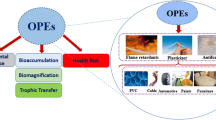Abstract
Chemical concentrations and distributions in an aquatic food web were studied to quantify the relative importance of chemical properties versus food web processes in determining exposure dynamics of organic contaminants in aquatic ecosystems. Five organochlorines were measured (Pentachlorobenzene QCB, Hexachlorobenzene HCB, Octachlorostyrene OCS, Dichlorodiphenyldichloroethylene DDE and Polychlorinated Biphenyls PCBs) in the food web of Lake St. Clair. Levels of QCB in aquatic organisms ranged from 1.0 to 25 µg kg−1 lipid, and levels of HCB ranged from 10 to 410 µg kg−1 lipid. More elevated concentrations of OCS (13 to 392 µg kg−1 lipid), DDE (162 to 11 986 µg kg−1 lipid) and PCB (650 to 64 900 µg kg−1 lipid) were observed. Organism — water equilibrium ratios were calculated for all species sampled to quantify the importance of food web processes in regulating contaminant exposure dynamics. Correlations of organism — water equilibrium ratios with body size were not significant for QCB, HCB and OCS (P>0.1), but were found to be significant for DDE and PCB (P<0.01).
Results support the conclusion that both chemical properties and food web dynamics regulate the distribution and concentration of organochlorines in aquatic ecosystems. Food web processes are important, however, for chemicals, that are not metabolized and have octanol — water partition coefficients (log K ow) greater than 5.5.
Similar content being viewed by others
References
Borgmann, U. & D. M. Whittle, 1983. Particle-size-conversion efficiency and contaminant concentrations in Lake Ontario biota. Can. J. Fish. aquat. Sci. 40: 328–336.
Connolly, J. P. & C. J. Pedersen, 1988. A thermodynamic-based evaluation of organic chemical accumulation in aquatic organisms. Envir. Sci. Technol. 22: 99–103.
Flint, R. W., W. H. McDowell & G. Yogis, 1988. Potential use of organochlorine contaminants to validate a food web model. Verh. int. Ver. Limnol. 23: 265–270.
Hebert, C. E. & G. D. Haffner, 1991. Habitat partitioning and contaminant exposure in cyprinids. Can. J. Fish. aquat. Sci. 48: 261–266.
Lazar, R., R. C. Edwards, C. D. Metcalfe, T. Metcalfe, F. A. P. C. Gobas & G. D. Haffner, 1992. A simple, novel method for quantitative analysis of coplanar (non-ortho substituted) polychlorinated biphenyls in environmental samples. Chemosphere. 25: 493–504.
Macek, K. J., S. R. Petrocelli & B. H. Sleight, III, 1979. ‘Considerations in assessing the potential for, and significance of, biomagnification of chemical residue in aquatic food chains’. In Aquatic Toxicology, ASTM STP 667, American Society for Testing and Materials, pp. 251–268.
Mackay, D. & S. Paterson, 1982. Fugacity revisited. Envir. Sci. Technol. 16: 654A-660A.
Neely, W. B., D. R. Bransen & G. E. Blair, 1974. Partition coefficient to measure bioconcentration potential of organic chemicals in fish. Envir. Sci. Technol. 8: 1113–1115.
Oliver, B. G. & A. J. Niimi, 1988. Trophodynamic analysis of polychlorinated biphenyl congeners and other chlorinated hydrocarbons in the Lake Ontario system. Envir. Sci. Technol. 22: 388–397.
Quinn, F. H., 1992. Hydraulic residence times for the Laurentian Great Lakes. J. Great Lakes Res. 18: 22–28.
Rasmussen, J. B., D. J. Rowen, D. R. S. Lean & J. H. Carey, 1990. Food chain structure in Ontario lakes determines PCB levels in lake trout and other pelagic fish. Can. J. Fish. aquat. Sci. 47: 2030–2038.
Veith, G. D., D. I. Dafoe & B. V. Bergstedt, 1979. Measuring and estimating the bioconcentration factor in fish. J. Fish Res. Bd Can. 36: 1040–1048.
Author information
Authors and Affiliations
Rights and permissions
About this article
Cite this article
Haffner, G.D., Tomczak, M. & Lazar, R. Organic contaminant exposure in the Lake St. Clair food web. Hydrobiologia 281, 19–27 (1994). https://doi.org/10.1007/BF00006552
Received:
Revised:
Accepted:
Published:
Issue Date:
DOI: https://doi.org/10.1007/BF00006552




